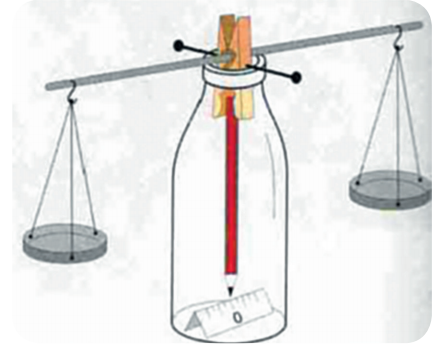



two balloons, string, PET bottle (or glass bottle), sand, wooden skewers, cork stopper (or clothes pin)
Teacher asks the pupils if they think the air has some weight. He discusses the topic with the pupils, finding out their ideas about the air. The task of the pupils will be to propose how they can determine and measure whether the air has any weight. If the pupils do not propose any procedure, the teacher asks them how to find out whether the inflated balloon is heavier than the deflated one. He will allow the pupils time to think about the procedure, or even to create a simple drawing. He then discusses their proposals with them, which they will implement (if possible).
If the pupils do not propose anything, the teacher presents them the figure in Worksheet 1, showing the isosceles weights. On both arms balloon is tied, while one is inflated and the other deflated. They can use a 1.5l–2l PET bottle to make the scales, which can be filled with sand (or they can use a glass bottle) for better stability. They will also need wooden skewers, a cork stopper/linen pin, and laces. Using the material they create isosceles weights (see picture,: http://meriamesvet.blogspot.sk). Instead of a laundry pin, they can use a cork stopper to drill the skewers (we recommend preparing the stoppers before activity).

The task of the pupils will be to wonder if the balloons have different or equal weight. They write down their predictions, and the teacher asks for its justification. They then verify their predictions by constructing simple isosceles balance. After verification, they write down the results and compare the findings with the predictions. They will draw a conclusion at the end of the activity, based on the data obtained.Through the activity, the pupils should realize that air is matter and has its weight. The more the balloon is inflated, the harder it will be.